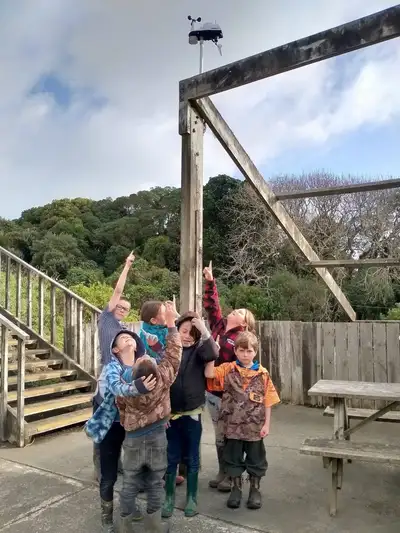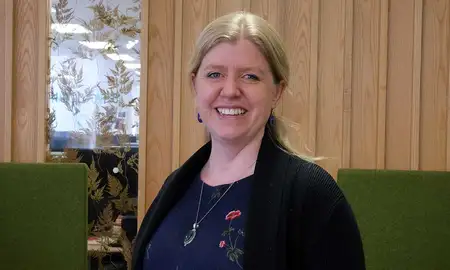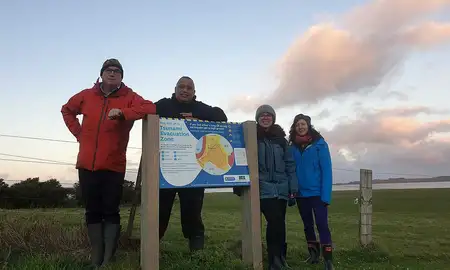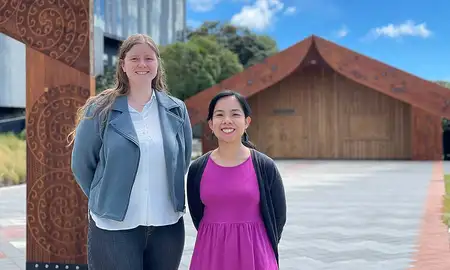
Professor David Johnston presenting on citizen science at the Asia-Pacific Ministerial Conference on Disaster Risk Reduction.
Whether it’s flooding or drought, heatwaves or blizzards, each year severe weather events have a devastating effect on the lives of millions around the world.
Massey University’s Joint Centre for Disaster Research (JCDR) is now part of a global effort to build resilience to high-impact weather by examining how 'citizen science' can contribute to better forecasting.
JCDR Lecturer Dr Marion Tan says, "The High-Impact Weather Project (HIWeather) is a 10-year research project with the World Meteorological Organisation (WMO) and the World Weather Research Programme, which started in 2016. It’s designed to make weather warnings much more effective."
Massey University has recently signed a contract with the WMO to support the citizen science aspect of the HIWeather project.
Citizen science is a collaboration between the general public and scientists in scientific research. The HIWeather project believes citizen science is an important and relatively underused link in what is termed the Warning Value Chain, made up of all the various people and organisations contributing to effective extreme weather warnings.
Different groups apply their different areas of expertise at each stage of the Warning Value Chain, but often there are gaps in the way information is shared – gaps which can potentially be bridged by using citizen science and local knowledge.
To help demonstrate the efficacy of citizen science to the scientific community, HIWeather held two workshops with 29 international experts discussing how citizen science can contribute to the Warning Value Chain. Based on the findings, JCDR and Australian Bureau of Meteorology researchers jointly put together the paper Exploring the Potential Role of Citizen Science in the Warning Value Chain in High Impact Weather, which was published in the journal Frontiers in Communication.
“A lot of the meteorological organisations are really good at the modelling, but we were looking at how we can engage with citizens a lot better, and at what stage in the value chain. This paper is a stepping stone to get people to talk about engaging with citizens. It provides scientists with evidence that citizen scientists can engage at many different points throughout the chain, thereby helping with awareness, education, preparation, and overall resilience," Dr Tan says.
Following the publication of the paper, HIWeather is highlighting citizen science success stories on its platform. In places like Australia and Europe, citizen science projects might involve the support of technology, like the development of specific apps.
“You also have projects that are not as technologically sophisticated but still engage with people, like in Ghana. They use existing tools like WhatsApp to gather weather observations and feedback from the public," Dr Tan adds.
Ghana has only a limited number of weather stations. The citizen scientists’ contributions have helped improve weather forecasting by filling data gaps. The highly interactive initiative has also helped communities improve their understanding of weather forecasts and warnings.
Some of the citizen science initiatives are quite unusual. One project HIWeather has highlighted is in China, where researchers use social media platforms like WeChat and Weibo to ask citizens to collect hailstones. These hailstones are carefully conserved and studied to understand how they form and grow, leading to a better understanding of their nature, and improved hailstorm forecasting. Farmers in particular have been willing to help out because hailstorms have a significant impact on their lives and crops.
Dr Tan says the HIWeather project is a global one. "Here in New Zealand, we also have some small projects we are trying to support. As part of that we’re working on weather-ready schools. We’re piloting that with schools on the Chatham Islands.”
Weather sensors have been installed at primary schools on the Chatham Islands where students and teachers can monitor the weather with their local stations and better understand weather hazards.

One of the weather sensors that has been installed at a school on the Chatham Islands.
“We have a good relationship with schools there, and the teachers are very keen. The important thing about citizen science is that there is reciprocity - it's not just top down with the scientists doing what they want. There should be mutual benefit,” Dr Tan says.
“We are always improving the science and technology to make warnings more effective, but we also want to highlight the need to engage with people to make weather information and warnings useful.”
In late September, JCDR Director Professor David Johnston presented at the Asia-Pacific Ministerial Conference on Disaster Risk Reduction in Brisbane, Australia.
The conference called for impact-based weather forecasting to be sped up and expanded. In addition, it called for universally accessible multi-hazard early warning systems, designed from start to finish with the needs of people and with gender inequalities in mind.
Related news
New partnership between Joint Centre for Disaster Research and Earthquake Commission
The Joint Centre for Disaster Research (JCDR) has developed a new partnership with the Earthquake Commission (EQC) to drive collaboration, coordination and alignment in disaster research.

Life in lockdown on the Chatham Islands
On Monday 16 August, Jennifer Lillo, Kelvin Tapuke and Professor David Johnston from the Joint Centre for Disaster Research (JCDR) set out to the Chatham Islands for an exciting week of science inspired events at the Festival of Science.

Massey researchers awarded Earthquake Commission Biennial Grants
Three Massey University researchers have been awarded a total of nearly $200,000 from the Earthquake Commission, to help New Zealanders better understand our natural hazard risk and identify ways to reduce the impact of those hazards.
